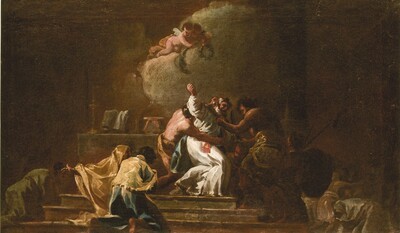- Cronología
- Ca. 1772 - 1774
- Dimensiones
- 35 x 60 cm
- Técnica y soporte
- Oil on canvas
- Reconocimiento de la autoría de Goya
- Attributed work
- Titular
- Private collection
- Ficha: realización/revisión
- 24 Aug 2022 / 08 Jun 2023
- Inventario
- 225
Together with Death of St. Albert of Jerusalem they were located in the convent of Carmelitas Descalzas de Cuenca, and made known as works of Goya by Tabar in 2014. There is no record of when they joined the convent and under what circumstances. It cannot be excluded that they came, in turn, from the convent of San Clemente de Cuenca, since this denomination appears in pencil on the back of one of the frames.
This episode of Jesus childhood was depicted in a wooded setting with twilight. he scene is reduced to the fundamental elements, outlining the figures in the foreground with loose but precise brushstrokes. The contrasting play of light and shadow emphasizes the nocturnal setting. In 1773-1774 Goya painted a cycle of mural scenes on the life of the Virgin in the Carthusian monastery of Aula Dei (Zaragoza), all in horizontal format and of a stylistic stage very close to the painting now catalogued.
These include The Escape to Egypt, which is one of the scenes that has not been preserved. As there is documentary evidence that sketches for these Aula Dei paintings existed but were never found, it has been speculated that there is a possible link between them and the Cuenca painting, although it is not necessarily assumed to be one of these lost sketches. It has also been associated with three drawings in the Italian Notebook (pg. 68, 69 and 146) in which a head of a donkey is depicted, reminiscent of the one in the painting.
-
2008
-
Goya y Zaragoza (1746-1775). Sus raíces aragonesasMuseo Goya. Colección IbercajaZaragoza2015cat. 14
-
Servicios de Publicaciones de la Universidad de Castilla- La Mancha,2008pp. 88-89
-
Madrid2014pp. 96-107
-
Goya y Zaragoza (1746-1775). Sus raíces aragonesasZaragozaFundación Goya en Aragón, Ibercaja y Gobierno de Aragón2015pp. 134-136

